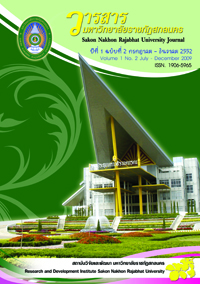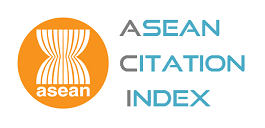การพัฒนากิจกรรมการเรียนรู้โดยใช้หลักซิปปา ในวิชาคณิตศาสตร์ เรื่องความน่าจะเป็น สำหรับนักเรียน ชั้นมัธยมศึกษาปีที่ 3 โรงเรียนเศรษฐบุตรบำเพ็ญ
Abstract
บทคัดย่อ
การวิจัยครั้งนี้มีวัตถุประสงค์เพื่อพัฒนากิจกรรมการเรียนรู้วิชาคณิตศาสตร์โดยใช้หลักซิปปา และเพื่อ ศึกษาผลการเรียนรู้จากการจัดกิจกรรมการเรียนรู้วิชาคณิตศาสตร์โดยใช้หลักซิปปา (Cippa Model) กลุ่มเป้าหมาย เป็นนักเรียนชั้นมัธยมศึกษาปีที่ 3/6 จำนวน 57 คน ภาคเรียนที่ 2 ปีการศึกษา 2551 โรงเรียนเศรษฐบุตรบำเพ็ญ สังกัดสำนักงานเขตพื้นที่การศึกษากรุงเทพมหานคร เขต 2 กิจกรรมการเรียนรู้โดยใช้หลักซิปปาประกอบด้วย ขั้นตอนการเรียนรู้ 7 ขั้นตอน ได้แก่ 1) ขั้นนำและขั้นทบทวนความรู้เดิม 2) ขั้นการแสวงหาความรู้ใหม่ 3) ขั้นการศึกษาทำความเข้าใจข้อมูล/ความรู้ใหม่และเชื่อมโยงความรู้ใหม่กับความรู้เดิม 4) ขั้นการแลกเปลี่ยน ความรู้ความเข้าใจกับกลุ่ม 5) ขั้นการสรุปและจัดระเบียบความรู้ 6) ขั้นการแสดงผลงาน 7) ขั้นการประยุกต์ ใช้ความรู้ จำนวน 4 แผน ดำเนินการตามวิธีวิจัยเชิงปฏิบัติการ 4 ขั้นตอน ได้แก่ 1) ขั้นวางแผน 2) ขั้นการปฏิบัติ 3) ขั้นการสังเกต 4) ขั้นการสะท้อนผลการปฏิบัติ จำนวน 4 วงจรปฏิบัติการ เวลาสอนทั้งหมด 11 คาบ คาบละ 50 นาที เครื่องมือที่วัดความเหมาะสมของกิจกรรรมการเรียนรู้โดยใช้หลักซิปปา ประกอบด้วย แบบประเมินทักษะ/กระบวนการด้านการทำงานกลุ่ม แบบประเมินคุณลักษณะอันพึงประสงค์ การบันทึก อนุทินสะท้อนการเรียนรู้ของนักเรียน และแบบบันทึกข้อมูลผลการจัดกิจกรรมการเรียนรู้วิชาคณิตศาสตร์ ส่วนเครื่องมือที่วัดพัฒนาการการเรียนรู้ ประกอบด้วย แบบทดสอบย่อยและแบบทดสอบวัดผลสัมฤทธิ์ ทางการเรียน วิเคราะห์ข้อมูลเชิงปริมาณด้วย ค่าร้อยละ ค่าเฉลี่ย ค่าเบี่ยงเบนมาตรฐานและวิเคราะห์ข้อมูล เชิงคุณภาพด้วยการวิเคราะห์เนื้อหา
ผลการวิจัยพบว่า 1) การจัดกิจกรรมการเรียนรู้วิชาคณิตศาสตร์โดยใช้หลักซิปปา ทำให้นักเรียนเกิด ความกระตือรือร้น ตื่นตัว สามารถพัฒนาความคิดและใช้ความคิดได้อย่างเต็มที่ จากการลงมือปฏิบัติกิจกรรม ทุกอย่างด้วยตนเอง ทำให้เกิดการเรียนรู้ทั้งทางด้านทักษะการแสวงหาความรู้ทักษะการอยู่ร่วมกันทางสังคม ที่ต้องอาศัยการปฏิสัมพันธ์กับเพื่อนๆ ทำให้เกิดการกล้าแสดงออก สามารถแลกเปลี่ยนความรู้ของตนเองกับ เพื่อนโดยใช้หลักเหตุผล มีความรับผิดชอบต่อตนเองและต่อส่วนรวม 2) ผลสัมฤทธิ์ทางการเรียนวิชาคณิตศาสตร์ ของนักเรียนโดยการจัดกิจกรรมการเรียนรู้โดยใช้หลักซิปปา มีพัฒนาการทางด้านความรู้อย่างต่อเนื่องจาก วงจรปฏิบัติการที่ 1 - 4 และมีผลสัมฤทธิ์ทางการเรียนวิชาคณิตศาสตร์สูงกว่าเกณฑ์ร้อยละ 70 คิดเป็นร้อยละ 77.19 นักเรียนพัฒนาทักษะ/กระบวนการด้านการทำงานกลุ่ม มีผลรวมของคะแนนเฉลี่ยอยู่ในเกณฑ์ดี คิดเป็น ร้อยละ 73.76 และนักเรียนพัฒนาคุณลักษณะที่พึงประสงค์ด้านความสนใจเรียนและความรับผิดชอบ โดยมีแนวโน้มพฤติกรรมต่างๆ ดีขึ้นและมีผลรวมของคะแนนเฉลี่ยอยู่ในเกณฑ์ดีและดีมาก คิดเป็นร้อยละ 76.75 และ 85.82 ตามลำดับ
Abstract
The purpose of this research was to develop the learning activity in Mathematics by using the Cippa Model, and to study the results from this learning activity in Mathematics by using the Cippa Model. The target group was 57 students in Mathayomsuksa 3/6 who were studying in 2nd semester of 2008 Academic Year, in the Setthabutbamphen School, which is under the Office of Bangkok Educational Service Area 2. The student should be performed with the development of learning activity using the Cippa Model which composed of 7 steps of learning procedures; 1) Introduction and review of background knowledge 2) Searching new knowledge 3) Study and understand the new information / knowledge that connecting of new and background knowledge 4) Exchange the knowledge and understanding in between the group 5) Conclusion and composition of the knowledge 6) Presentation of results 7) Application of the knowledge, in 4 plans that should be performed by 4 steps of the empirical procedures, those were 1) Planning 2) Performing 3) Observation 4) Reflection of the performing results in 4 Cycles. Total learning period was 11 periods, and 50 minutes per period. Tools used for measuring the appropriateness of the learning activity using Cippa Model were composed of the evaluation form for the skill / group working procedures, evaluation form for the desire characteristic, record of the students’ learning reflection, and the record of the results of Mathematic learning activity. Tools used for measurement of the learning development were composed of the sub-testing form, and learning achievement form. Data received were analyzed quantitatively using the percentage, arithmetic mean, standard deviation, and were analyzed qualitatively by contents analysis.
The results of the study were as follows: 1) the learning activity in Mathematics by using the Cippa Model encouraged students’ eagerness and alertness in learning and enabled them to develop thoughts and fully employed them. Because of performing all activities by themselves, students were, thus, encouraged to learn both searching for knowledge skill and social coexisting skill which required the interaction among friends. These caused students dare to express their performances, share their own knowledge with friends sensibly, and be responsible to both themselves and others. 2) The students’ learning achievement of Mathematics by means of organizing learning activities by using the Cippa Model was continuously developed from working cycle 1 – 4 and the achievement of learning Mathematics was 77.19 percent which was higher than the 70 average percentage. Also, students developed skillfulness/group working procedures about which the sum of the average percentage scores was 73.76 at good level. What’s more, students developed the desired characteristic regarding their intention and responsibility. Generally, students’ behavioral trends were better and the average percentage scores were 76.75 and 85.82, at good level and excellent level respectively.








